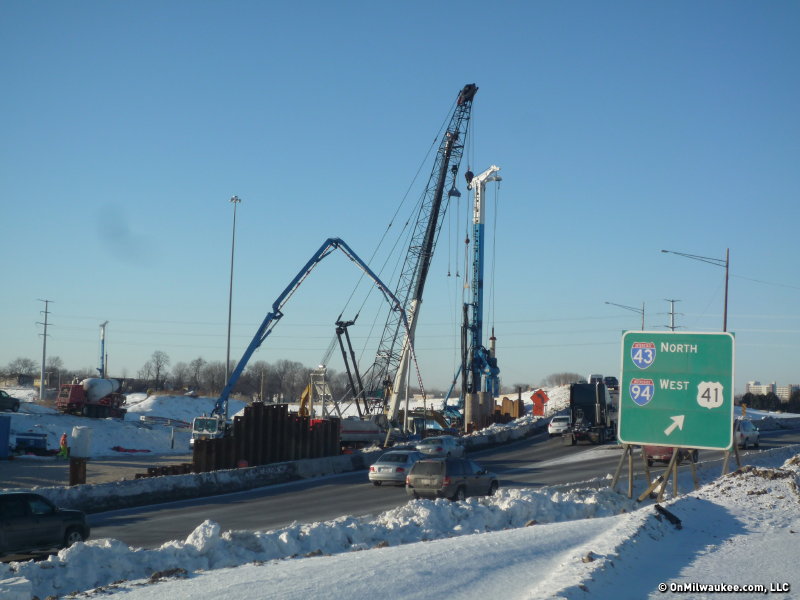If your regular, daily commute takes you into Downtown through the Mitchell Interchange, you'll want to start leaving a little earlier.
Beginning tonight, the ramp connecting eastbound I-43/894 to westbound (northbound) I-43/94 will close until December to facilitate construction of a new tunnel through the interchange. Ramps connecting S. 27th Street to and from eastbound I-894 will also close.
It's all part of a $162 million project to rebuild the aging Mitchell Interchange -- itself, part of a larger, $1.9 billion project to completely reconstruct I-94 from Downtown Milwaukee to the Illinois state line.
To accommodate the traffic shift, all lanes of eastbound I-894 beginning at S. 60th Street will close at 11 p.m. Friday, reopening at 8:30 a.m. Saturday.
Bridges give way to tunnels
Completed in the 1960s, the Mitchell Interchange carries an average of 195,000 vehicles each day.
When the project is complete late next year, three tunnels will carry traffic through the interchange. Two of them, approximately 600 and 800 feet long, respectively, will carry traffic from eastbound to northbound while a third will carry traffic southbound through the interchange.
The use of tunnels is a different approach than taken when the Marquette Interchange was rebuilt. That structure included five levels of ramps and is the interchange's most recognizable feature.
Such a design wouldn't be feasible at the Mitchell Interchange.
"Tunnel systems were the most economical choice for this location," says Ryan Luck, WisDOT construction chief.
Unlike most tunnels, these are not being bored into the ground. Essentially, the roadway will be excavated and laid with four-foot thick walls before a cap is installed above the roadway, completing the tunnel.
Each of the tunnels will have 12-foot-wide travel lanes with both left and right shoulders and a minimum height of 16 feet-9 inches. Advanced light, ventilation and drainage systems have been incorporated into the design, too.
Lighting will assist drivers' eyes in adjusting from outdoor to indoor light and back again. The lights will actually be dimmer during the night and brighter during the day, requiring less adjustment by drivers' eyes.
"It sounds kind of contradictory," says Tim Vik, a traffic operations engineer with HTNB, one of about 50 contractors working on the project. "But it's designed so there isn't a shock to the eyes when you're driving through."
Every fourth tunnel light and all signage lighting will be equipped with emergency generators in case of a power outage. The tunnels will also include emergency exits and access points in the event of fire or other serious accident.
"It's really a worse-case scenario, but those are the things we needed to take into account," Vik says.
Plan ahead
Travelers who usually utilize that connection can use one of two different posted detour routes:
- Howard Avenue -- Exit I-43/94 at Loomis Road; take Loomis Road north to Howard Avenue; take Howard Avenue east to I-43/94.
- Layton Avenue -- Exit I-43/894 at S. 35th Street; take 35th Street south to Layton Avenue; take Layton Avenue east (left) to WIS 794; WIS 794 (I-94) north (left) into Downtown.
To accommodate higher-than-usual traffic levels, WisDOT has worked to resurface the streets and upgrade the intersections along both routes. Traffic signals along Layton and Howard Avenues and Loomis Road have been adjusted to allow detour traffic more time to get through intersections.
The Milwaukee County Transit System will add service to the Loomis/Southridge Flyer (Route 46). Beginning Monday, two Downtown trips serving the Southridge, Loomis Road and Holt Avenue Park and Ride Lots will be added to the morning schedule. A limited-service evening tip connecting riders from Southride to Downtown Milwaukee and two evening trips from Downtown to the Holt, Loomis and Southridge lots will be added.
Buses, too, will have to adjust their routes due to the project, though no stops will be affected.
Control room operators at the Statewide Traffic Operations Center in Downtown Milwaukee will monitor the traffic situation and a series of overhead and roadside signs will alert drivers to delays and travel times. A new flashing sign has been installed to alert drivers of delays approaching the interchange.
Sensors have been installed just before the Loomis Interchange and again just east of S. 60th Street. Those sensors will activate blinkers on the sign so drivers aren't surprised by slow or stalled traffic when approaching the work zone.
Drivers can get updated information from WisDOT's traveler-information Website, 511wi.gov or by calling 511. The Mitchell Interchange project team also provides updates on Twitter and Facebook.
3-D Animation of the new EB-NB configuration:
Courtesy: Wisconsin Department of Transportation





